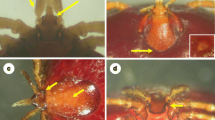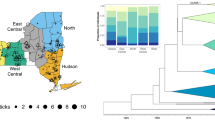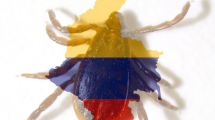Abstract
The genetic structure of populations of the tick Amblyomma ovale from five distinct areas of the Brazilian Atlantic rainforest was evaluated via DNA sequencing and associated with the presence of domestic dogs acting as hosts at the edge of forest fragments. Ticks were collected from domestic dogs and from the environment between 2015 and 2017. Four collection areas were located in the surroundings and within the Serra do Mar State Park, São Paulo State (23°37′21"S, 45°24′43"W), where dogs were bimonthly monitored along 2 years using camera traps and GSM trackers. To determine the spatial limits of genetic structure, ticks collected upon dogs living near the Serra do Baturié, Ceará State (4°15′40"S, 38°55′54"W) were included as well. A total of 39 haplotypes of 16S rRNA and Cox 1 mitochondrial genes sequences were observed, with 27 of them coming from areas within the Serra do Mar State Park. No haplotype was shared between the Serra do Mar and the Serra do Baturié indicating isolation of tick populations at the scale of 2000 km. Although three different haplotype lineages of A. ovale occurred within the Serra do Mar State Park, no genetic structure was found across the study sites within this park, suggesting high tick gene flow across a range of 45 km. Monitoring data from domestic dogs and wild carnivores showed that these species share the same habitats at the forest edge, with dogs playing a likely limited role in tick dispersal. Our findings have important implications for understanding the genetic structure of wide spread A. ovale along Brazilian rainforest remnants, which can further be associated to tick-borne infectious agents, such as Rickettsia parkeri, and used for predicting future patterns of tick diversity in the Brazilian Atlantic rainforest.


Similar content being viewed by others
References
Aragão HB, Fonseca F (1961) Notas de Ixodologia: IX. O complexo ovale do gênero Amblyomma. Memórias do Instituto Oswaldo Cruz 59:131–148. https://doi.org/10.1590/S0074-02761961000200002
Arzua M, Brescovit AD (2006) Métodos de coleta e preservação para identificação. In: Barros-Battesti DM, Arzua M, Bechara GH (eds) Carrapatos de importância médico-veterinária da região neotropical: um guia ilustrado para identificação de espécies, 1st edn. Vox/ICTTD-3/Butantan, São Paulo, pp 183–189
Bandelt HJ, Forster P, Röhl A (1999) Median-joining networks for inferring intraspecific phylogenies. Mol Biol Evol 16:37–48. https://doi.org/10.1093/oxfordjournals.molbev.a026036
Barbieri JM, Da Rocha CMBM, Bruhn FRP, Cardoso DL, Pinter A, Labruna MB (2015) Altitudinal assessment of Amblyomma aureolatum and Amblyomma ovale (Acari: Ixodidae), vectors of spotted fever group rickettsiosis in the State of São Paulo, Brazil. J Med Entomol 52:1170–1174. https://doi.org/10.1093/jme/tjv073
Barros-Battesti DM, Arzua M, Bechara. GH (2006) Carrapatos de importância médico veterinária da região neotropical: um guia ilustrado para identificação de espécies, 1st edn. São Paulo
Black WC, Piesman J (1994) Phylogeny of hard- and soft-tick taxa (Acari: Ixodida) based on mitochondrial 16S rDNA sequences. Proc Natl Acad Sci USA 91:10034–10038
Butler JR, Bingham J (2000) Demography and dog-human relationships of the dog population in Zimbabwean communal lands. Vet Rec 147:442–446. https://doi.org/10.1136/VR.147.16.442
Castilho CS, Marins-Sá LG, Benedet RC, Freitas TRO (2012) Genetic structure and conservation of Mountain Lions in the South-Brazilian Atlantic Rain Forest. Genet Mol Biol 35:65–73
De Meeus T (2012) Initiation à la génétique des populations naturelles applications aux parasites et à leurs vecteurs, IRD edn. Marseille
Dupanloup I, Schneider S, Excoffier L (2002) A simulated annealing approach to define the genetic structure of populations. Mol Ecol 11:2571–2581. https://doi.org/10.1046/j.1365-294X.2002.01650.x
Dupraz M, Toty C, Noël V, Estrada-Peňa A, González-Solís J, Boulinier T, Dujardin JP, McCoy KD (2016) Linking morphometric and genetic divergence with host use in the tick complex, Ornithodoros capensis sensu lato. Infect Genet Evol 46:12–22. https://doi.org/10.1016/j.meegid.2016.10.005
Excoffier L, Smouse PE, Quattro JM (1992) Analysis of molecular variance inferred from metric distances among DNA haplotypes: application to human mitochondrial DNA restriction data. Genetics 131:479–491
Frigeri E, Cassano CR, Pardini R (2014) Domestic dog invasion in an agroforestry mosaic in southern Bahia, Brazil. Trop Conserv Sci 7:508–528. https://doi.org/10.1177/194008291400700310
Fu YX (1997) Statistical tests of neutrality of mutations against population growth, hitchhiking and background selection. Genetics 147:915–925
Galetti M, Sazima I (2006) Impact of feral dogs in an urban Atlantic forest fragment in southeastern Brazil. Natureza Conservação 4:146–151
Gigliotti C, Santos MJ (2013) A Expansão Urbana de Caraguatatuba (1950–2010): uma Análise das Transformações Sócio Espaciais. Caminhos de Geografia 14. http://www.seer.ufu.br/index.php/caminhosdegeografia/article/view/17794. Accessed 10 July 2017
Guglielmone AA, Estrada-Peña A, Keirans JE, Robbins RG (2003) Ticks (Acari: Ixodida) of the neotropical zoogeographic region. Atlanta Houten, International Consortium on Ticks and Tick-borne Diseases, p 173
IBGE (2017) IBGE | Brasil em Síntese | São Paulo | Caraguatatuba | Panorama [WWW Document]. https://cidades.ibge.gov.br/brasil/sp/caraguatatuba/panorama. Accessed 10 July 17
Kearse M, Moir R, Wilson A, Stones-Havas S, Cheung M, Sturrock S, Buxton S, Cooper A, Markowitz S, Duran C, Thierer T, Ashton B, Meintjes P, Drummond A (2012) Geneious Basic: an integrated and extendable desktop software platform for the organization and analysis of sequence data. Bioinformatics 28:1647–1649. https://doi.org/10.1093/bioinformatics/bts199
Krawczak SF, Labruna MB (2018) The rice rat Euryoryzomys russatus, a competent amplifying host of Rickettsia parkeri strain Atlantic rainforest for the tick Amblyomma ovale. Ticks Tick Borne Dis 9:1133–1136. https://doi.org/10.1016/j.ttbdis.2018.04.013
Krawczak FS, Agostinho WC, Polo G, Moraes-Filho J, Labruna MB (2016a) Comparative evaluation of Amblyomma ovale ticks infected and noninfected by Rickettsia sp. strain Atlantic rainforest, the agent of an emerging rickettsiosis in Brazil. Ticks Tick Borne Dis 7:502–507. https://doi.org/10.1016/j.ttbdis.2016.02.007
Krawczak FS, Munoz-Leal S, Guztzazky AC, Oliveira SV, Santos FCP, Angerami RN, Moraes-Filho J, de Souza JC, Labruna MB (2016b) Rickettsia sp. strain atlantic rainforest infection in a patient from a spotted fever-endemic area in southern Brazil. Am J Trop Med Hyg 95:551–553. https://doi.org/10.4269/ajtmh.16-0192
Labruna MB, Sanfilippo LF, Demetrio C, Menezes AC, Pinter A, Guglielmone AA, Silveira LF (2007) Ticks collected on birds in the state of Sao Paulo, Brazil. Exp Appl Acarol 43:147–160
Librado P, Rozas J (2009) DnaSP v5: a software for comprehensive analysis of DNA polymorphism data. Bioinformatics 25:1451–1452. https://doi.org/10.1093/bioinformatics/btp187
Luz HR, Faccini JLH (2013) Ticks on Brazilian birds: overview. In: Birds—evolution and behaviour, breeding strategies, migration and spread of disease, vol 1, pp 97–126. https://doi.org/10.1007/s10493-012-9572-7
Martins TF, Moura MM, Labruna MB (2012) Life-cycle and host preference of Amblyomma ovale (Acari: Ixodidae) under laboratory conditions. Exp Appl Acarol 56:151–158. https://doi.org/10.1007/s10493-011-9506-9
Martins TF, Peres MG, Costa FB, Bacchiega TS, Appolinario CM, Antunes JMA, de P, Vicente, Megid AF, Labruna J, Martins MB, Peres TF, Costa MG, Bacchiega FB, Appolinario TS, Antunes CM, JMA de P, Vicente, Megid AF, Labruna J, M.B (2016) Ticks infesting wild small rodents in three areas of the state of São Paulo, Brazil. Ciência Rural 46:871–875. https://doi.org/10.1590/0103-8478cr20150671
Maturano R, Faccini JH, Daemon E, Fazza PC, Bastos R (2015) Additional information about tick parasitism in Passeriformes birds in an Atlantic Forest in southeastern Brazil. Parasitol Res 114:4181–4193. https://doi.org/10.1007/s00436-015-4651-4
Mazé-Guilmo E, Blanchet S, Mccoy KD, Loot G (2016) Host dispersal as the driver of parasite genetic structure: a paradigm lost? Ecol Lett 19:336–347. https://doi.org/10.1111/ele.12564
McCoy KD, Léger E, Dietrich M (2013) Host specialization in ticks and transmission of tick-borne diseases: a review. Front Cell Infect Microbiol 3:1–12. https://doi.org/10.3389/fcimb.2013.00057
Mouret S (2017) Revolução Industrial no Brasil—Início, incentivo e consequências. https://www.estudopratico.com.br/revolucao-industrial-no-brasil/. Accessed 10 July 2017
Murgas IL, Castro AM, Bermúdez SE (2013) Current status of Amblyomma ovale (Acari: Ixodidae) in Panama. Ticks Tick Borne Dis 4:164–166. https://doi.org/10.1016/j.ttbdis.2012.09.002
Nadolny R, Gaff H, Carlsson J, Gauthier D (2015) Comparative population genetics of two invading ticks: evidence of the ecological mechanisms underlying tick range expansions. Infect Genet Evol 35:153–162. https://doi.org/10.1016/j.meegid.2015.08.009
Ogrzewalska M, Pacheco RC, Uezu A, Richtzenhain LJ, Ferreira F, Labruna MB (2009) Ticks (Acari: Ixodidae) infesting birds in an Atlantic rain forest region of Brazil. J Med Entomol 46:1225–1229. https://doi.org/10.1603/033.046.0534
Ogrzewalska M, Uezu A, Jenkins CN, Labruna MB (2011) Effect of forest fragmentation on tick infestations of birds and tick infection rates by Rickettsia in the Atlantic Forest of Brazil. EcoHealth 8:320–331. https://doi.org/10.1007/s10393-011-0726-6
Ogrzewalska M, Saraiva DG, Moraes-Filho J, Martins TF, Costa FB, Pinter A, Labruna MB (2012) Epidemiology of Brazilian spotted fever in the Atlantic Forest, state of São Paulo, Brazil. Parasitology 139:1283–1300. https://doi.org/10.1017/S0031182012000546
Ogrzewalska M, Literák I, Capek M, Sychra O, Calderón V, Rodríguez BC, Prudencio C, Martins TF, Labruna MB (2015) Bacteria of the genus Rickettsia in ticks (Acari: Ixodidae) collected from birds in Costa Rica. Ticks Tick Borne Dis 6:478–482. https://doi.org/10.1016/j.ttbdis.2015.03.016
Pinter A, Horta MC, Pacheco RC, Moraes-Filho J, Labruna MB (2008) Serosurvey of Rickettsia spp. in dogs and humans from an endemic area for Brazilian spotted fever in the State of São Paulo, Brazil. Cadernos de Saúde Pública 24: 247–252. https://doi.org/10.1590/S0102-311X2008000200003
Ramos DG, Melo AL, Martins TF, Alves AS, Pacheco TA, Pinto LB, Pinho JB, Labruna MB, Dutra V, Aguiar DM, Pacheco RC (2015) Rickettsial infection in ticks from wild birds from Cerrado and the Pantanal region of Mato Grosso, midwestern Brazil. Ticks Tick Borne Dis 6:836–842. https://doi.org/10.1016/j.ttbdis.2015.07.013
Ribeiro MC, Metzger JP, Martensen AC, Ponzoni FJ, Hirota MM (2009) The Brazilian Atlantic Forest: how much is left, and how is the remaining forest distributed? Implications for conservation. Biol Conserv 142:1141–1153. https://doi.org/10.1016/j.biocon.2009.02.021
Sabatini GS, Pinter A, Nieri-Bastos FA, Marcili A, Labruna MB (2010) Survey of ticks (Acari: Ixodidae) and their rickettsia in an Atlantic rain forest reserve in the State of São Paulo, Brazil. J Med Entomol 47:913–916. https://doi.org/10.1603/ME10073
Schnell JK, Harris GM, Pimm SL, Russell GJ (2013) Quantitative analysis of forest fragmentation in the atlantic forest reveals more threatened bird species than the current red list. PLoS One 8:e65357. https://doi.org/10.1371/journal.pone.0065357
Simon C, Frati F, Beckenbach A, Crespi B, Liu H, Flook P (1994) Evolution, weighting, and phylogenetic utility of mitochondrial gene sequences and a compilation of conserved polymerase chain reaction primers. Ann Entomol Soc Am 87:651–701. https://doi.org/10.1093/aesa/87.6.651
Spolidorio MG, Labruna MB, Mantovani E, Brandão PE, Richtzenhain LJ, Yoshinari NH (2010) Novel spotted fever group Rickettsiosis, Brazil. Emerg Infect Dis 16:521–523. https://doi.org/10.3201/eid1603.091338
Szabó MP, Nieri-Bastos FA, Spolidorio MG, Martins TF, Barbieri AM, Labruna MB (2013) In vitro isolation from Amblyomma ovale (Acari: Ixodidae) and ecological aspects of the Atlantic rainforest Rickettsia, the causative agent of a novel spotted fever rickettsiosis in Brazil. Parasitology 140: 719–728. https://doi.org/10.1017/S0031182012002065
Tajima F (1989) Statistical method for testing the neutral mutation hypothesis by DNA polymorphism. Genetics 123:585–595
Tamura K, Stecher G, Peterson D, Filipski A, Kumar S (2013) MEGA6: molecular evolutionary genetics analysis version 6.0. Mol Biol Evol 30:2725–2729. https://doi.org/10.1093/molbev/mst197
Verdade LM, Campos CB (2004) How much is a puma worth? economic compensation as an alternative for the conflict between wildlife conservation and livestock production in Brazil. Biota Neotrop 4:1–4. https://doi.org/10.1590/S1676-06032004000200014
Acknowledgements
We would like to thank Olivier Duron for helpful discussions. This work was not possible without financial support from FAPESP from processes 2014/648-3 and 2016/5355-0 (BEPE). Partial funding for this work came from the ANR Grant ESPEVEC (ANR blanc ANR-13-BSV7-0018-01) to KDM. This study was financed in part by the Coordenação de Aperfeiçoamento de Pessoal de Nível Superior–Brasil (CAPES)–Finance Code 001.
Author information
Authors and Affiliations
Corresponding author
Additional information
Publisher’s Note
Springer Nature remains neutral with regard to jurisdictional claims in published maps and institutional affiliations.
Electronic supplementary material
Below is the link to the electronic supplementary material.
10493_2019_350_MOESM2_ESM.tif
Figure 3 Gray-scale heatmap matrixes calculated upon the alignments of 275 bp partial fragments of 16S rRNA (A) and cox1 (B) genes from Serra do Baturié (A5) and Serra do Mar State Park (A1–A4) populations of A. ovale. In each tree, Serra do Baturié sequences are denoted with orange and Serra do Mar State Park sequences with blue branches. Evolutionary relationships were inferred using Tamura-Nei genetic distance model. Support values obtained after 1000 bootstrap replications are indicated for main branches. Resulting trees were midpoint-rooted and transformed to cladrograms (TIF 12968 KB)
Rights and permissions
About this article
Cite this article
Fournier, G.F.S.R., Pinter, A., Santiago, R. et al. A high gene flow in populations of Amblyomma ovale ticks found in distinct fragments of Brazilian Atlantic rainforest. Exp Appl Acarol 77, 215–228 (2019). https://doi.org/10.1007/s10493-019-00350-y
Received:
Accepted:
Published:
Issue Date:
DOI: https://doi.org/10.1007/s10493-019-00350-y




